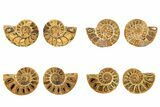Orange, Jurassic-Aged Cut & Polished Ammonite Fossils - 1 1/4 to 1 1/2"
These are cut and polished orange ammonites collected near Sakaraha in the Tulear Province of Madagascar. Most of the cut and polished ammonites from Madagascar are Cretaceous in age, but those with an orange/yellow/pink coloration are often Late Jurassic (Oxfordian Stage) in age. The photos are representative examples of what they look like. For each ammonite ordered you will receive both halves. There is some variation in size, but they range from approximately 1 1/4 to 1/2" wide (each half)
The previously hollow chambers of the ammonite were replaced with a beautiful agate during the fossilization process. Some of these chambers are still partially hollow and lined with druzy crystals. The ammonite was cut in half and polished revealing the inner chamber structure of this ancient marine animal.
The previously hollow chambers of the ammonite were replaced with a beautiful agate during the fossilization process. Some of these chambers are still partially hollow and lined with druzy crystals. The ammonite was cut in half and polished revealing the inner chamber structure of this ancient marine animal.
About Ammonites
Ammonites were ancient marine cephalopods, similar to today's squids and octopuses, but with a defining feature: their distinctive, tightly coiled spiral shells. These shells, resembling those of modern nautiluses, served as both a protective home and a buoyancy aid, allowing ammonites to navigate the prehistoric seas with ease. First emerging around 240 million years ago in the Triassic Period, ammonites thrived for over 175 million years, adapting through numerous forms and sizes. As predatory creatures, they likely fed on smaller marine organisms, using their tentacles to capture prey. However, their long reign came to an end 65 million years ago at the close of the Cretaceous, coinciding with the mass extinction event that also eliminated the dinosaurs.
Ammonites were ancient marine cephalopods, similar to today's squids and octopuses, but with a defining feature: their distinctive, tightly coiled spiral shells. These shells, resembling those of modern nautiluses, served as both a protective home and a buoyancy aid, allowing ammonites to navigate the prehistoric seas with ease. First emerging around 240 million years ago in the Triassic Period, ammonites thrived for over 175 million years, adapting through numerous forms and sizes. As predatory creatures, they likely fed on smaller marine organisms, using their tentacles to capture prey. However, their long reign came to an end 65 million years ago at the close of the Cretaceous, coinciding with the mass extinction event that also eliminated the dinosaurs.
$7
Quantity Discounts
3 to 9 Pieces
$6
10+ Pieces
$5
TYPE OF FOSSIL
Ammonite
SPECIES
Various
AGE
Late Jurassic (~160 Million Years)
LOCATION
Sakaraha, Tulear Province, Madagascar
SIZE
Approximately 1 1/4 to 1 1/2" across (each side)
PRODUCT ID
P-1043
 Reviews
Reviews













